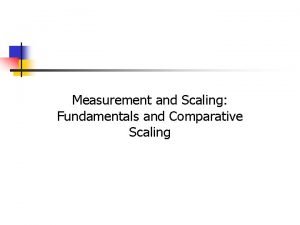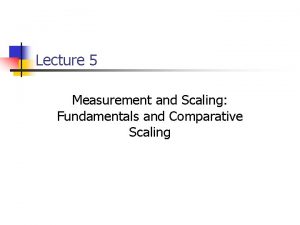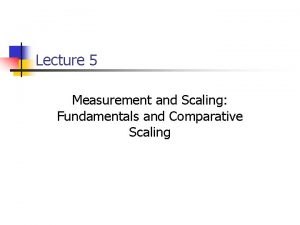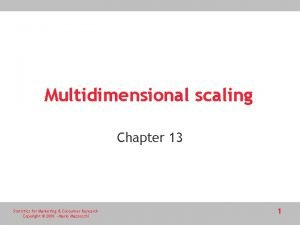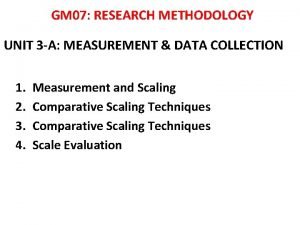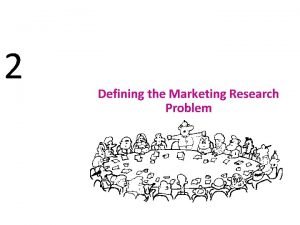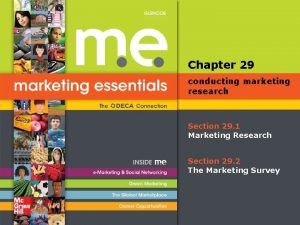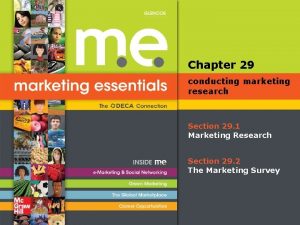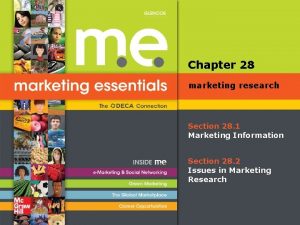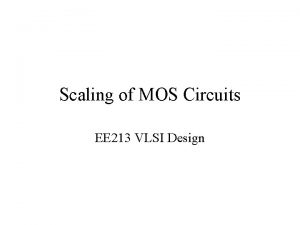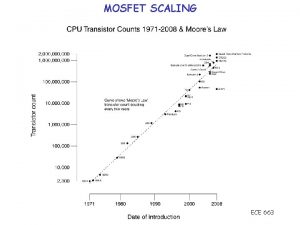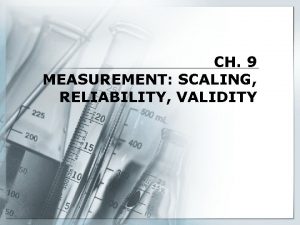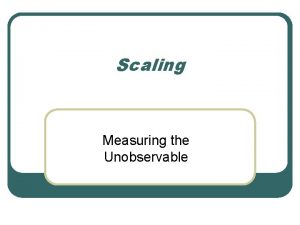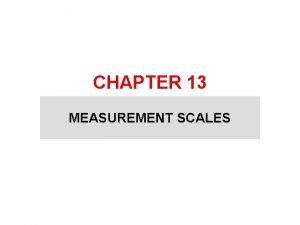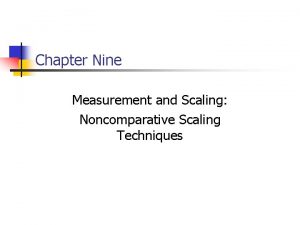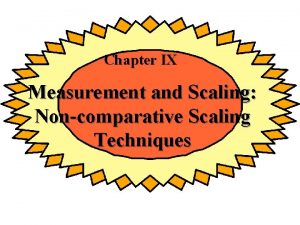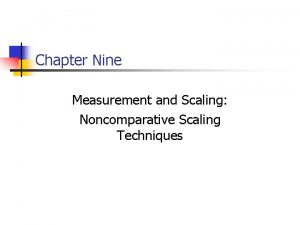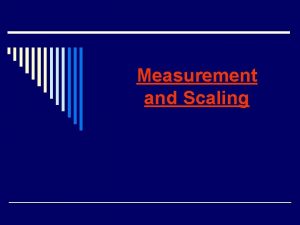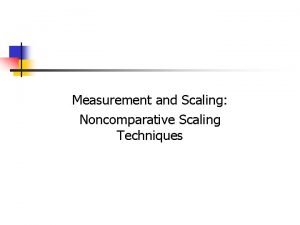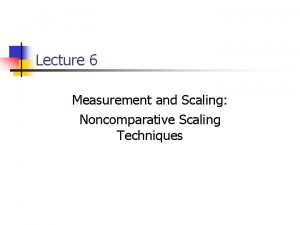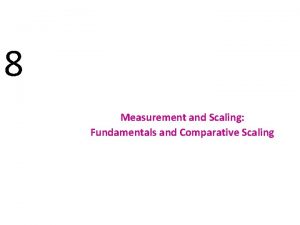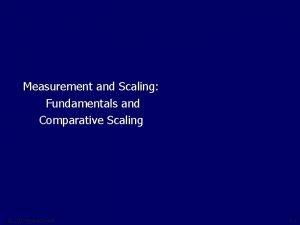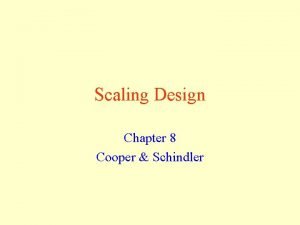Chapter 4 Measurement in Marketing Research Measurement Scaling


































- Slides: 34

Chapter 4 -Measurement in Marketing Research

Measurement & Scaling Measurement – Process of assigning numbers to objects to measure amount of attributes. Rules – A guide. Scale

Measurement Scales Nominal - Counting Ordinal – Median / Mode Interval - Mean Ratio – Geometric Mean

Difficulty in Measurement needs to measure ‘internal’ subjective states of individual consumers constructs: mental abstractions that form the basis for modeling the behavior of larger systems involving many individuals constitutive definition defines a construct with other constructs, as in a dictionary operational definition specifies how a construct is to be measured

Example of concepts: mass , love, strength, advertising effectiveness, consumer attitude, market share Example of constructs: consumer attitude, advertising effectiveness. Constructs are concepts used for research purpose. Construct ‘attitude’ may be defined as a learned tendency to respond in a consistent manner with respect to a given object of orientation’ or as’ latent dispositions toward objects’ Constructs that can be measured and quantified are called variables. They…vary!

Operational definition Height: Measure 1: in inches, with a ruler with the person wearing shoes Measure 2: in inches, with a ruler w/out the person wearing shoes Measure 3: Measured by an altimeter or barometer Measure 4: Measured by the number of hands

Operational definition Purchase intentions: measured as answer to: I will definitely purchase Brand x…………… I probably will purchase Brand x……………. I probably will not purchase Brand x………… I definitely will not purchase Brand x………… Can you think of an alternative operationalization?

Measurement Scales Nominal - Counting Ordinal – Median / Mode Interval - Mean Ratio – Geometric Mean

Scale Types

Scale Types

Scale Types Please divide 100 points among each of the following soft drinks according to your degree of liking for each. Coke ____ Pepsi ____ Dr. Pepper ____ Sprite ____

Scale Nominal Ordinal Interval Ratio Basic Typical Comparisons Example s Identity Male-female User-nonuser Occupations Uniform numbers Order Comparison of intervals Comparison of absolute magnitudes Preference for brands Social class Hardness of minerals Graded quality of lumber Temperature scale Grade point average Attitude toward brands Awareness of advertising Units sold Number of purchasers Probability of purchase Weight Measures of Average Mode Median Mean Geometric mean Harmonic mean

Reliability – consistency of measures– should capture the core concept. Test-retest reliability Equivalent forms Internal consistency Split-half Cronbach alpha

Reliability

Reliability

Validity Face validity. Content validity. Criterion-related validity – the degree to which an instrument can predict Predictive – FUTURE - SAT scores; Attitudes. Concurrent - CURRENT Construct validity – the degree to which a measure confirms a theory based upon the concepts Discriminant Convergent

Reliability and Validity

Scaling Issues Graphic Rating Scales A graphic continuum typically anchored by two extremes. Easily constructed and simple to use. Ability to discern fine distinctions. Itemized Rating Scales Respondents must select from a limited number of ordered categories rather than placing a check mark on a continuous scale.

Three Types of Graphic Rating Scales Scale A Uncomfortable Comfortable Scale B 0 10 Uncomfortable 20 30 40 50 Neutral 60 70 80 90 100 Comfortable

Three Types of Graphic Rating Scales Scale C 1 Very very Uncomfortable 2 3 4 5 6 7 8 9 10 Very very Comfortable

Exhibit 8. 13 Graphic Rating Scale

Attitude Measurement Scales To learn about various types of attitude scales. Rank Order Scale Respondent judges one item against another Paired Comparison Scales Asks a respondent to pick one of two objects from a set based upon some stated criteria. The respondent makes a series of paired judgments between objects. Constant Sum Scales Requires the respondent to divide a given number of points, typically 100, among two or more attributes based on the importance to the person.

Exhibit 8. 14 Comparative Rating Scales

Attitude Measurement Scales To learn about the various types of attitude scales. The Semantic Differential • Begins with the determination of a concept to be rated. • The researcher selects opposite pairs of words or phrases that describe the object • Respondents rate on a scale. • The mean is computed and plotted as a profile or image.

Semantic Differential

Attitude Measurement Scales To learn about the various types of attitude scales. Stapel Scale Designed to measure both the direction and intensity of attitudes simultaneously. Likert Scales • A series of statements that express either a favorable or unfavorable attitude toward the concept under study. • The respondent is asked the level of agreement or disagreement with each statement.

Exhibit 8. 9 Likert Scale Example

The Validity and Reliability Concepts Sources of measurement error: 1. respondent characteristics, such as mood 2. situational factors, such as time of day 3. data collection factors, such as the influence of the interviewing method 4. measuring instrument factors, such as flawed survey questions 5. data analysis factors, such as coding error total measurement error = systematic error (e. S, consistent bias) plus random error (e. R)

Estimating Validity is the extent to which measurement is free from both systematic and random error – its overall accuracy. It is estimated with: construct validity: compares measurements from the construct of interest and related constructs content (face) validity: compares measurements with judgments by experts concurrent validity: compares two different measurements of the same marketing phenomenon at the same point in time predictive validity: compares measurements at one point in time with predicted measurements at a future point in time

Estimating Reliability is the extent to which a measurement is free from random errors – its consistency, precision, and predictability. It is estimated with: test-retest reliability: compares repeated measurements using the same scaling device under similar conditions on the same subjects alternative-forms reliability: compares measurements between two equivalent but not identical forms, administered to the same subjects split-half reliability: compares measurements between equivalent groups of item responses in a multi-item measurement device

A Model of Behavioral Response The hierarchy-of-effects model hypothesizes that the buyer's response falls along a spectrum for each component of attitude. cognitive (or belief) component – respondent's awareness of and knowledge about object affective (or feeling) component – respondent's liking of and preference for object behavioral component – respondent's intention to buy and purchase behavior

A Model of Behavioral Response (cont. ) Figure 4 -4 Model of Behavioral Response

Verbal Rating Scales-Issues to consider for design of verbal rating scales: 1. 2. 3. 4. 5. 6. 7. 8. 9. 10. overall number of categories odd or even number of categories balanced vs. unbalanced scale extent of verbal description category numbering forced vs. non-forced scales comparative vs. non-comparative scales symmetric vs. asymmetric scales scale direction choice of endpoints

 Comparative scaling techniques
Comparative scaling techniques Measurement and scaling
Measurement and scaling Primary scales of measurement
Primary scales of measurement What is comparative scale
What is comparative scale Interval scale example
Interval scale example Multidimensional scaling in marketing
Multidimensional scaling in marketing Constant sum scale example
Constant sum scale example Marketing research measurement scales
Marketing research measurement scales Primary scales of measurement in marketing research
Primary scales of measurement in marketing research Attitude measurement in marketing research
Attitude measurement in marketing research Finer segmentation strategies
Finer segmentation strategies Marketing information systems and marketing research
Marketing information systems and marketing research Define marketing information management
Define marketing information management Marketing information systems and marketing research
Marketing information systems and marketing research Marketing information system kotler
Marketing information system kotler Marketing information systems and marketing research
Marketing information systems and marketing research Market problem example
Market problem example Chapter 29 conducting marketing research answers
Chapter 29 conducting marketing research answers What is forced choice questions
What is forced choice questions Chapter 28 marketing research
Chapter 28 marketing research Chapter 28 marketing research
Chapter 28 marketing research Introduction to marketing research chapter 1
Introduction to marketing research chapter 1 The marketing research process follows five steps
The marketing research process follows five steps Chapter 28 marketing research
Chapter 28 marketing research Scaling bridge
Scaling bridge Decision tree scaling
Decision tree scaling Scaling factors for device parameters in vlsi
Scaling factors for device parameters in vlsi Scaling memcache at facebook
Scaling memcache at facebook Kv-40rw
Kv-40rw Operator position for scaling
Operator position for scaling Scaling by powers of ten
Scaling by powers of ten Powers of ten
Powers of ten Smartphone energy consumption
Smartphone energy consumption Receive side scaling
Receive side scaling Retrograde well
Retrograde well
